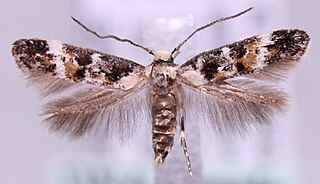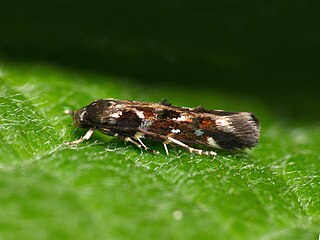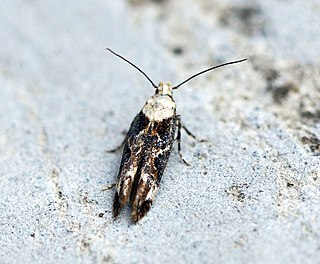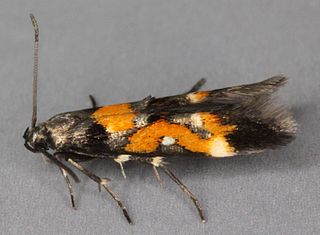
The willowherb hawkmoth is a moth in the family Sphingidae. The species was first described by Peter Simon Pallas in 1772.

Mompha raschkiella is a species of micromoth in the family Momphidae. The moth was first described by German entomologist Philipp Christoph Zeller in 1838.

Mompha idaei is a moth in the family Momphidae first described by Zeller in 1839. It has a Holarctic distribution, in North America it is found from coast to coast in the boreal forest south to Colorado and Washington.

Mompha epilobiella is a moth in the family Momphidae found in Europe and North America.

Mompha ochraceella is a moth of the family Momphidae found in Africa, Asia and Europe.

Mompha subbistrigella, the garden cosmet, is a moth of the Momphidae family found in most of Europe.

Mompha langiella is a moth of the family Momphidae. It is found in most of Europe, except parts of the Balkan Peninsula and the Mediterranean islands.

Mompha is a genus of moths in the family Momphidae that was first described by Jacob Hübner in 1819. It has four subgenera.

Mompha lacteella is a moth in the family Momphidae found in Asia and Europe.

Mompha propinquella is a moth in the family Momphidae found in Europe.

Mompha terminella is a moth in the family Momphidae found in Europe and North America.

Mompha divisella is a moth in the family Momphidae. It found from southern Scandinavia to the Caucasus and central Asia.
Mompha bradleyi is a moth in the family Momphidae found in Europe.
Mompha confusella is a moth in the family Momphidae. It found from central and southern Europe to Transcaucasia. In Europe, it has been recorded from the Czech Republic, Austria, Hungary, Slovakia, Ukraine and Russia.

Mompha sturnipennella is a moth in the family Momphidae. It is found in the Holarctic ecozone and is found in most of Europe, Siberia, the Russian Far East and Canada.
Mompha meridionella is a moth in the family Momphidae that can be found in the northern Caucasus and Greece.
Mompha jurassicella is a moth in the family Momphidae that can be found in western Europe. The range extends to Switzerland in the east.

Mompha miscella is a moth in the family Momphidae, found in Asia Minor, Europe and North Africa.

Mompha locupletella is a moth in the family Momphidae that can be found in the Palearctic including Europe.

Scythris inspersella, the Norfolk owlet, is a moth of the family Scythrididae, first described by the German entomologist Jacob Hübner in 1817. It has a Holarctic distribution.














